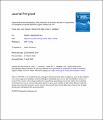Superoxide-driven autocatalytic dark production of hydroxyl radicals in the presence of complexes of natural dissolved organic matter and iron
Xiao, Y., Carena, L., Näsi, M.-T., & Vähätalo, A. V. (2020). Superoxide-driven autocatalytic dark production of hydroxyl radicals in the presence of complexes of natural dissolved organic matter and iron. Water Research, 177, Article 115782. https://doi.org/10.1016/j.watres.2020.115782
Julkaistu sarjassa
Water ResearchPäivämäärä
2020Tekijänoikeudet
© 2020 Elsevier Ltd.
We introduced superoxide as potassium superoxide (KO2) to artificial lake water containing dissolved organic matter (DOM) without or with introduced ferric iron complexes (DOM-Fe), and monitored the production rate of hydroxyl radicals as well as changes in the absorption and fluorescence properties of DOM. The introduction of KO2 decreased the absorption by DOM but increased the spectral slope coefficient of DOM more with complexed ferric Fe than without it. The introduction of KO2 increased the fluorescence of humic-like components in DOM without introduced ferric Fe but resulted in the loss of fluorescence in DOM with introduced ferric Fe. A single introduction of 13 μmol L−1 KO2 produced 10 μmol L−1 and 104 μmol L−1 hydroxyl radicals during a week-long experiment without and with the introduced DOM-Fe complexes, respectively. The production rate of hydroxyl radicals decreased exponentially with time but levelled off and continued several days in DOM with introduced ferric Fe. These findings suggest that in the presence of DOM-Fe complexes, superoxide can trigger an autocatalytic Fenton reaction that produces hydroxyl radicals and breaks down DOM. ...
...
 ...
...
Julkaisija
ElsevierISSN Hae Julkaisufoorumista
0043-1354Asiasanat
Julkaisu tutkimustietojärjestelmässä
https://converis.jyu.fi/converis/portal/detail/Publication/35193994
Metadata
Näytä kaikki kuvailutiedotKokoelmat
Rahoittaja(t)
Suomen AkatemiaRahoitusohjelmat(t)
Tutkijatohtori, SALisätietoja rahoituksesta
This study was financially supported by the Academy of Finland Grant (No. 295709) and Taishan Scholar Foundation of Shandong Province (No. tsqn201909126). The stay of L.C. in Jyväskylä was financially supported by the Erasmus + Traineeship programme. L.C. acknowledges Compagnia di San Paolo (Torino, Italy) for financially supporting his Ph.D. fellowship.Lisenssi
Samankaltainen aineisto
Näytetään aineistoja, joilla on samankaltainen nimeke tai asiasanat.
-
Step-by-step analysis of drinking water treatment trains using size-exclusion chromatography to fingerprint and track protein-like and humic/fulvic-like fractions of dissolved organic matter
Ignatev, Alexey; Tuhkanen, Tuula (Royal Society of Chemistry, 2019)This paper provides a glimpse into the removal of dissolved organic matter (DOM) during conventional drinking water treatment and evaluates the potential of high-performance size-exclusion chromatography (HPSEC) as a ... -
Coupling of iron and dissolved organic matter in lakes–selective retention of different size fractions
Riise, Gunnhild; Haaland, Ståle Leif; Xiao, Yihua (Springer, 2023)Increasing concentration of iron (Fe) is observed in many boreal lakes, such as for the present study in Oslo Østmark, SE-Norway (1983–2018). As Fe-regulating processes are complex and dynamic, the link between mobilizing ... -
Temporal perspective of humification of organic matter
Koivula, Niina (University of Jyväskylä, 2004)Humustumisprosessissa kuollut orgaaninen aines hajoaa maaperässä. Osa tästä orgaanisesta aineesta mineralisoituu hiilidioksidiksi ja vedeksi lopun jäädessä maaperään ja muodostaa humusaineita, joita ovat humushappo, ... -
Plastic and terrestrial organic matter degradation by the humic lake microbiome continues throughout the seasons
Vesamäki, Jussi S.; Laine, Miikka B.; Nissinen, Riitta; Taipale, Sami J. (Wiley, 2024)Boreal freshwaters go through four seasons, however, studies about the decomposition of terrestrial and plastic compounds often focus only on summer. We compared microbial decomposition of 13C-polyethylene, 13C polystyrene, ... -
Production of ethyl lactate by activated carbon-supported Sn and Zn oxide catalysts utilizing lignocellulosic side streams
Kupila, Riikka; Lappalainen, Katja; Hu, Tao; Heponiemi, Anne; Bergna, Davide; Lassi, Ulla (Elsevier, 2021)In this study, activated carbon-supported Sn and Zn oxide catalysts were prepared from hydrolysis lignin and used for the conversion of model solutions of trioses, hexoses, and lignocellulosic biomass hydrolysates to ethyl ...
Ellei toisin mainittu, julkisesti saatavilla olevia JYX-metatietoja (poislukien tiivistelmät) saa vapaasti uudelleenkäyttää CC0-lisenssillä.

